
Take nine strategic goals, six academic priorities, 12 schools, five years and close to a billion dollars and what do you get?
By John Prendergast | Photos by Gregory Benson (Civic House photo by Tommy Leonardi.)
If you visit the Web site of the University’s journal of record, Almanac, at (www.upenn.edu/almanac) and scroll down the right hand side of the page, you can access the documentary history of the University’s just-concluded strategic plan, The Agenda for Excellence. It begins with the plan itself, dated November 21, 1995 and the product of many months of discussion and debate going back to the earliest days of the administration of Dr. Judith Rodin CW’66. This document outlines the Agenda’s nine strategic goals—from the overarching (“The University will solidify and advance its position as one of the premier research and teaching universities in the nation and in the world”) to the down-to-earth (“The University will identify and secure the funds required to support its strategic goals.”).
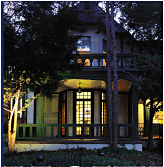
Next comes Six University Academic Priorities, posted September 24, 1996, which sets out a half-dozen broad areas for special attention: Life Science, Technology and Policy; American and Comprehensive Democratic and Legal Institutions; Management, Leadership and Organization; The Humanities—Meaning in the 21st Century; The Urban Agenda; and Information Science, Technology and Society. This was followed by the strategic plans of the University’s 12 schools and centers, posted on January 21, 1997.
Finally, dated May 1, 2001, is Agenda for Excellence, 1995-2000, which reports, in considerable detail—and very small print—on the results of the plan. The prose does not exactly sing, but what the closely packed columns of type add up to is a half-decade of impressive and varied activity that has affected virtually every aspect of the University. For those wishing to avoid eyestrain, here are some selected highlights from the report:
To put the last goal first, about $952 million was raised for the priorities outlined in the Agenda, out of a total of $1.5 billion raised during the period. This included about $300 million for financial aid and other student needs and $543 million for faculty and academic programs.
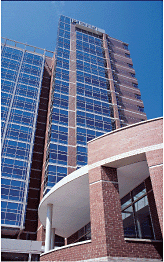
By the available measures, Penn is certainly more in demand today than it was five years ago. The University has moved up 10 notches in the rankings published in U.S. News & World Report, going from 16th in 1994 to sixth in the most recent edition. Also, the number of students applying here has gone up, their quality is higher, and Penn is doing a better job at convincing them to attend once they’ve been accepted. The number of applicants went from 13,700 to 19,000 for the Class of 2005, and the yield—the percentage of accepted students who choose to matriculate at Penn—was 55.5 percent in 2000 vs. 47 percent in 1994. Meanwhile, average SAT scores continue to climb, from 1378 to 1412. As the report puts it, “Penn has clearly accomplished the goal of being considered a school of choice for the ablest undergraduates in the nation and the world.”
Making the experience of undergraduates at Penn more fulfilling was a major focus of the Agenda, through expanded academic options, increased opportunities for original research, an enhanced living/learning environment, and more funding for student financial aid.
According to the report, Penn offers more joint and dual-degree programs and opportunities for cross-disciplinary study than any other institution in America—thanks to continuing development of Penn’s traditional strength in this area. Eight new joint and dual-degree programs have been started since 1995, and the “numerous” cross-disciplinary programs include Molecular Life Sciences, designed for undergraduates seeking careers in the biological sciences, and Digital Media Design, a collaboration between the School of Engineering and Applied Science, the Annenberg School for Communication, and the Graduate School of Fine Arts.
To provide more research opportunities for undergraduates, in Fall 2000, the Center for Undergraduate Research and Fellowships (CURF) was established to serve as a clearinghouse for undergraduates interested in participating in research while at Penn or in applying for post-baccalaureate fellowships. And the University offers more than 75 academic service-learning courses, making it one of the nation’s leaders in these types of courses, which combine coursework with related real-world community service.
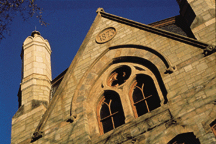
The creation of the College House system in 1999 was another signature development relating to undergraduate life. Each of the 12 College Houses, which accommodate a total of 5,400 undergraduates, has a live-in faculty master, house dean, and advisers. Through a program known as the Wheel, students have around-the-clock access to in-person and online advising in math, writing, library research, foreign languages, computer science and engineering, and career services. Each house also has its own computer lab, with staff that can provide quick help for hardware and software problems whenever they occur.
In addition to the 12 residences, two “hubs” for special interests established themselves on campus during this period. The first, Kelly Writers House, has become ground zero for all things literary on campus, while Civic House is headquarters for community-service activities. Other hubs are in the planning stages—for example, in science and technology and performing arts.
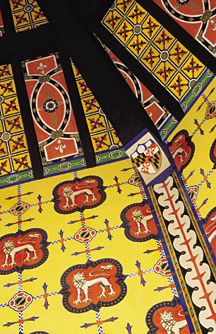
Some $138 million has been raised for undergraduate financial aid, and $75 million for graduate and professional students. Nearly 400 new scholarship funds have been established.
Recruiting and retaining top-flight faculty is key both to educating students and to extending Penn’s standing as a leading research institution. The 1995-2000 period has seen significant growth in the number of endowed professorships established at Penn. University faculty have also been able to attract a growing share of funding for sponsored research.
Penn has added 57 new endowed professorships during the Agenda—key bargaining chips in attracting the best and brightest academics. Formerly on the faculty at Princeton, Dr. John DiIulio C’80 G’80 was named a Fox Leadership Professor, for example. DiIulio, who recently resigned a head of President Bush’s office of faith-based programs, is one of several new faculty in political science—a department singled out in the Agenda as both central to Penn’s academic priorities and in need of rebuilding. Other new faculty include Dr. Lawrence Sherman, one of the world’s leading criminologists, who came to Penn to direct the Fels Center of Government [“A Passion for Evidence,” March/April 2000].
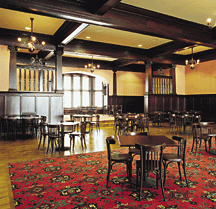
Growth in external funding for research by Penn faculty has accelerated from 2 percent annual growth in 1995 to 11 percent annually over the last five years, and jumped by 13 percent in FY2000. That year, the University received nearly $540 million in external funding, up from $322 million in FY95.
New research centers established during the Agenda include the Leonard and Madlyn Abramson Family Cancer Research Institute; the Center for Cognitive Neuroscience, focusing on studies of the mind, brain, and behavior; the Center for Bioinformatics, designed to link biomedical researchers, computer scientists, and mathematicians working on computationally intensive research; and the University-wide Genomics Institute [“Gazetteer,” May/June].
Perhaps the most concrete (and brick, and steel, and glass) evidence of change over the last five years has been the explosion of construction activity on and around the campus, which has included an array of both commercial and academic space.
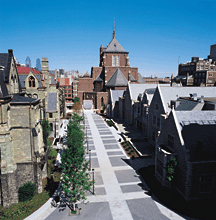
Falling into the category of major campus amenities are Sansom Common and the Perelman Quadrangle. Sansom Common, completed in 1999, transformed a surface parking lot at 36th and Walnut into a major crossroads of the University, anchored by the Penn Bookstore and the Inn at Penn, and including several restaurants and retail establishments. Perelman Quad, completed in fall 2000, combined extensive renovations of four of Penn’s most historic structures (College Hall, Houston Hall, Logan Hall, and Irvine Auditorium) and one 1960s-era building, Williams Hall, with construction of a new central plaza, Wynn Commons, to create a new hub of undergraduate life.

New academic facilities include the Biological Research Building II/III and the Roy and Diana Vagelos Laboratories, both completed early in the Agenda period. Buildings currently under construction include Huntsman Hall for the Wharton School; Melvin J. and Clair Levine Hall, which will double the space for Computer Science—where the University is also investing in 10 new faculty chairs; the dental school’s new building, the Schattner Center; and the Mainwaring wing of the University of Pennsylvania Museum of Archaeology and Anthropology, which will provide state-of-the-art storage for the Museum’s collections. In the planning stages are a new life-sciences building to house the departments of biology and psychology and another building for bioengineering.
Facilities that were renovated included the Annenberg School for Communication; the former faculty club, Skinner Hall, which was converted into the Charles Addams Fine Arts Hall; the Library; the Graduate School of Education’s building; Logan Hall; and the Law School’s Silverman Hall.
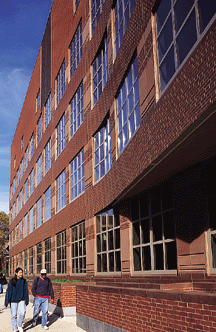
With the University’s acquisition of the former Christian Association at 36th and Locust Walk, the building has become the Arts, Research and Culture House (ARCH), a center for student cultural and performing arts organizations. Also new to Locust Walk is a Graduate Student Center, scheduled to open this fall.
New athletic facilities include the Pottruck Center, currently under construction, which will make for a renovated and expanded Gimbel Gymnasium, plus renovations to the Palestra and improvements to Murphy and Bower fields, among other projects.
At 40th Street, the multi-story Freshgrocer foodmarket and parking garage has been completed. Across Walnut Street, the planned multi-screen movie theater, delayed and somewhat altered as the result of the financial troubles of General Cinemas (the backer of Penn’s original partner in the deal, Robert Redford’s Sundance Cinema) will eventually add to the street’s vitality. (At this writing, the University is negotiating with another partner, National Amusements.)
To the east, a former industrial building at 31st and Chestnut owned by the University has been turned into a luxury-apartment complex called the Left Bank—an outpost in a planned future Penn expansion toward Center City (see story on page 19).
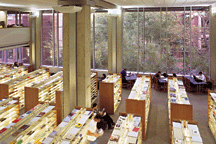
Under the Agenda, the University has also made a major investment in West Philadelphia to make the streets cleaner and safer, has increased mortgage guarantees and other incentives to Penn people to buy homes in the area, and has committed to construct and support a new pre-K-8 public school in the neighborhood. Though the process has at times been stormy, the school is scheduled to open this month for kindergarten and first grade. Besides committing $700,000 annually for at least 10 years to the new school, the University has also pledged help to more disadvantaged schools nearby.
“Happily, Penn’s progress has been remarkable over the past five years,” say the authors of the report. In a Gazette interview that begins on the following page, President Rodin offers this assessment: “We are where we should be, but we can’t rest on our laurels … I think we can stop for a moment and really enjoy where we’ve gotten through the Agenda for Excellence, but we need to continue to be nimble and to think strategically because that’s in part what got us there.”
Speaking specifically of the progress made on the six academic priorities, Rodin says, “Can I claim victory? Not 100 percent, but in the low 90s.”
Which is still pretty good—excellent, even.
—JP
PART II
Assessing the Agenda
As the five years covered by the University’s strategic pan, The Agenda for Excellence, drew to a close, Gazette editor John Prendergast talked with President Rodin about the Universiy’s numerous successes during this period, a few near-misses, and what lies ahead for Penn.
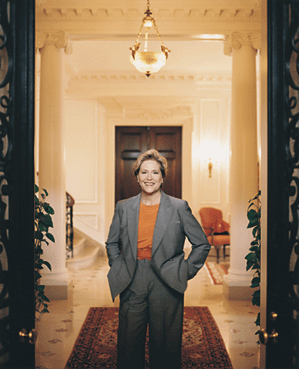
Some of the thinking behind the Agenda for Excellence seems to go back as far as your inaugural address as Penn’s president, when you said, “We will design a new Penn undergraduate experience. It will involve not only curriculum, but new types of housing, student services, and mentoring, to create a seamless experience between the classroom and the residence, from the playing field to the laboratory.” And in your very first “From College Hall” column for the Gazette in February 1996, you announced the development of the Agenda to alumni. Could we start by talking about the rationale for doing a plan like this?
I had the great luxury of being named president in November [1993] and not starting until July of the following year. During that period, I used the time, although I was still at Yale, to learn a great deal about Penn—to spend time here and also to engage some help learning what others thought about Penn. We had many, many focus groups going on campus, with faculty and students, with alumni groups, with college guidance counselors, with people in Philadelphia and our delegation in Harrisburg, and then at the national level as well. It gave me a comprehensive view of how Penn was perceived both from the inside and from the outside that helped to frame some of my own strategic thinking about what we needed to do, where we had areas of opportunity. That led to the notion of a strategic plan and how we would actually begin to accomplish some of these goals.
I think the second reason was that we were in the final year of a campaign [the $1.4 billion Campaign for Penn]. One of the things that I felt acutely was that Penn still lacked some of the resources that it needed to achieve its ambitions, and I wanted to make sure that in the next round of fundraising we would be able to articulate for our friends, our donors, and alumni what specifically our ambitions were and how specifically we would spend the money that we raised.
The first of the plan’s nine goals is “to solidify and advance [Penn’s] position as one of the premier teaching and research universities in the nation and in the world.” Has that been achieved to your satisfaction?
To my satisfaction? That’s a harder question. We certainly have raised the profile of Penn by every objective indicator and by lots of qualitative ones as well. Whether it’s rankings, elections to honorary societies for our students or the faculty, the perception by our peers or the regard of our alumni—in all of those indicators I think that Penn has clearly moved into the pantheon of one of the few truly great research universities in the world. It’s where we needed to be, it’s where we deserved to be—but we needed some work to get there.
The University moved from 16th in 1994 to sixth in the most recent rankings in U.S. News & World Report. Could you talk about the whole notion of rankings, about which you and other heads of institutions have expressed reservations. What is their value?
The rankings are too non-scientific, and the reason that institutional presidents really feel strongly about not solely relying on them is that they move around, that there are not statistically significant differences between the various ranks and the like, but the truth is that the general public reads these entities and they are influenced by them. In some ways they become self-fulfilling prophecies, and to ignore that is foolish, actually, because they do matter, whether we like it or not.
Having said that, we’re not mindlessly pursuing the rankings. That’s why I talked about seeing ourselves within a key cohort. We think the cohort that includes Harvard, Yale, Princeton, MIT, Caltech, and Stanford ought to include Penn. That’s where we think we need to be now. There may be some movement in the rankings, but that’s not really the important thing.
There are other quality indicators—the applicant pool is over the top—and you have all of those as well. We think that those demonstrate that we are where we should be, but we can’t rest on our laurels. We need to stay there, and sometimes it’s harder to stay there than it is to get there. I think we can stop for a moment and really enjoy where we’ve gotten through the Agenda for Excellence, but we need to continue to be nimble and to think strategically, because that’s in part what got us there.

